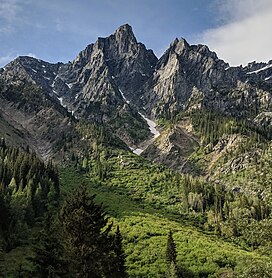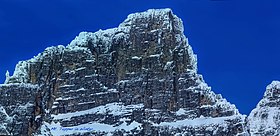| Mount Tupper | |
|---|---|
 Mount Tupper seen from Highway 1 | |
| Highest point | |
| Elevation | 2,804 m (9,199 ft) [1] |
| Prominence | 254 m (833 ft) [1] |
| Parent peak | Swiss Peak [1] |
| Coordinates | 51°20′09″N 117°29′55″W / 51.33583°N 117.49861°W [2] |
| Geography | |
| District | Kootenay Land District |
| Parent range | Selkirk Mountains |
| Topo map | NTS 82N6 Blaeberry |
| Geology | |
| Type of rock | quartzite |
| Climbing | |
| First ascent | 1906 Wolfgang Koehler, Edward Feuz Jr, Gottfried Feuz [1] |
Mount Tupper 2,804 m (9,199 ft) is a mountain about 37 kilometres (23 mi) west of Golden, British Columbia, Canada and three kilometres east of Rogers Pass in Glacier National Park. Part of the Selkirk Mountains, it was formerly named Hermit Mountain until renamed (1887) in honour of Sir Charles Tupper when he was minister of Railways and Canals in Sir John A. Macdonald's cabinet during the siting and construction of the CPR line through the Selkirk Mountains, and later Prime Minister. [2]
Raspberry Rising Cave
In 2013, the mountain was the scene of cave explorations by a team of eight, led by Nicholaus Vieira and funded by the Royal Canadian Geographical Society, who followed the Raspberry Rising cave system for nearly a kilometre, climbing two waterfalls and traversing four sumps. The end of the cave was not reached and further explorations are planned. [3] [4]
Climate
Based on the Köppen climate classification, Mount Tupper is located in a subarctic climate zone with cold, snowy winters, and mild summers. [5] Temperatures can drop below −20 °C with wind chill factors below −30 °C. Precipitation runoff from the mountain drains into the Beaver River which is a tributary of the Columbia River.

See also
References
- ^ a b c d "Mount Tupper". Bivouac.com. Retrieved 2014-03-29.
- ^ a b "Mount Tupper". BC Geographical Names. Retrieved 2014-03-29.
- ^ Joshua Rapp Learn (April 2014). "Cave Mappers". Canadian Geographic Magazine. p. 37.
- ^ "Raspberry Rising Project". crazycaver.com. Retrieved 2014-03-29.
- ^ Peel, M. C.; Finlayson, B. L.; McMahon, T. A. (2007). "Updated world map of the Köppen−Geiger climate classification". Hydrol. Earth Syst. Sci. 11 (5): 1633–1644. Bibcode: 2007HESS...11.1633P. doi: 10.5194/hess-11-1633-2007. ISSN 1027-5606.
External links
- Mount Tupper at bivouac.com
- " Mapping the Underworld," a 19-minute documentary by Carolyn Jarvis which takes the viewer inside Raspberry Rising Cave and shows how the expedition is assisting researchers in microbial studies (aired on Global Television on September 28, 2013). Note: most of the film is focused on Booming Ice Chasm.
- Parks Canada site: Glacier National Park
- Weather: Mount Tupper
